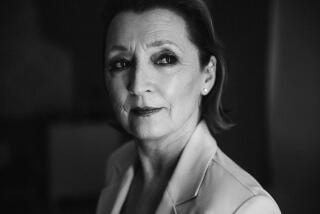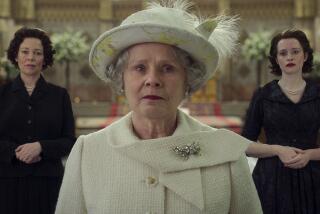‘The White Queen’ on Starz looks at the Wars of the Roses’ women
NEW YORK — A dashing young English royal falls for a beautiful commoner, and their love becomes a nationwide sensation that forever alters the face of the monarchy.
No, their names aren’t Will and Kate, but rather King Edward IV and Elizabeth Woodville. The year is 1464, nearly a decade into the Wars of the Roses, a time when (for those of you who dozed off during ninth grade history class) the English monarchy was violently contested between two competing branches within the House of Plantaganet.
By secretly marrying a 27-year-old, widowed mother of two aligned with the rival Lancaster clan, the Yorkist Edward IV added fuel to the Wars of the Roses, a bloody series of power struggles that would rage on for another 20 years.
PHOTOS: Hollywood Backlot moments
Now Edward and Elizabeth’s romance and the resultant upheaval are at the center of “The White Queen,” a new 10-episode period epic based on bestselling novels by Philippa Gregory which premiered Saturday on Starz. Their relationship was considered scandalous in those days, when duty trumped matters of the heart.
“Love was rarely taken into consideration,” said Max Irons, who plays the young king in the series, over a recent breakfast in Manhattan.
“When she meets Edward by the road and falls madly in love with him, just a boy meeting a girl, with that comes consequences,” added his costar, the Swedish actress Rebecca Ferguson, whose character is viewed with intense suspicion by Edward’s family and advisors — especially the powerful Earl of Warwick, known as the “Kingmaker” (James Frain).
In person, Irons and Ferguson have a playful, chummy relationship, marked by good-natured ribbing and inside jokes from their months together on set in Belgium. On-screen, however, their connection is more visceral: They spend a good portion of the series in various states of undress.
Given the unusually high bodice-ripping quotient in “The White Queen,” finding the right leading couple was essential. Irons was cast early in pre-production, but his queen proved more elusive. The actor had to go through 15 chemistry tests with potential costars before Ferguson came along — not that he’s complaining.
PHOTOS: Celebrities by The Times
“The long and the short of it is, you’ve got to do a bit of flirting,” Irons discreetly said of the process.
Acting lineage
The son of Oscar winner Jeremy Irons and Irish actress Sinead Cusack, the 27-year-old Irons knows a thing or two about being part of a dynasty. Still, he resisted the family business until the age of 16, when he starred in a Neil LaBute play at school. “This makes academia pale in comparison, this makes sports pale in comparison, and the girls like it, so I might keep doing it,” he decided.
For Ferguson, 29, acting was a somewhat less inevitable life path, despite what is a borderline spooky resemblance to fellow countrywoman Ingrid Bergman. As a teenager, she starred on the popular Swedish soap “Nya Tider,” but afterward retreated from the limelight, settling in a small seaside village where she worked as a dance instructor.
That is, until “The White Queen,” a job she landed after submitting a homemade audition tape, lured her back in front of the camera.
GRAPHIC - ‘Breaking Bad’ to ‘Justified’: Killing off your favorite stars
“I’ve never, ever, ever desperately wanted to act. I should probably say I do, but I don’t,” said Ferguson, who despite her ambivalence has several other projects lined up, including Brett Ratner’s “Hercules: The Thracian Wars” and “The Vatican” for Showtime.
Strong women
“The White Queen” is based on “The Cousins’ War,” Gregory’s series of novels chronicling the Wars of the Roses from the perspective of three women vying to maintain their proximity to the throne: In addition to Ferguson’s Elizabeth, there’s young Anne Neville (Faye Marsay), pawned off in a politically expedient marriage to the creepy Richard III, and Margaret Beaufort, played with wild-eyed intensity by Amanda Hale, whose son Henry VII would become the first Tudor monarch.
A co-production with the BBC, the project fit in nicely with Starz’s lineup of historical dramas “Spartacus” and “DaVinci’s Demons,” but also represented something of a departure — not just for the network, but for premium cable more broadly.
“It’s a story that we really hadn’t seen, women vying for power in a time and place where power wasn’t available to them,” said Carmi Zlotnik, managing director of original programming at Starz. (The series premiered earlier this summer in the U.K., where it received middling reviews, as it has in the U.S.)
Gregory, who says she was “without doubt born a feminist,” has made a career out of writing female-oriented historical fiction, like the novel-turned-film “The Other Boleyn Girl.” In her estimation, women like Elizabeth Woodville have gotten “terrible bad press” in the history books, thanks to the chaste monks who wrote them.
PHOTOS: Dysfunctional TV families
“They’re not going to describe powerful, active, sexy, ambitious women in tones of anything other than horror and terror,” Gregory said in an interview at the recent Television Critics Assn. gathering in Beverly Hills.
“The White Queen” is also somewhat novel in its focus on England’s Plantagenet monarchs, who ruled for more than three centuries, yet haven’t captivated the popular imagination in quite the same way as their Tudor successors, Henry VIII and Elizabeth I.
But fate, it seems, is conspiring to bring them back into the limelight: Just as production on “The White Queen” got underway in Belgium last September, the remains of the last Plantagenet king, Richard III — thought by many, including Shakespeare, to have orchestrated the murder of two of Elizabeth Woodville’s sons — were unearthed after five centuries in a parking lot in Leicester.
Then there’s HBO’s hit fantasy series “Game of Thrones,” inspired in part by the Wars of the Roses, whose ongoing success suggests viewers have an appetite for the complex, internecine struggles that defined this particular era in history. (The Starz version of the series even includes additional dialogue to help American viewers keep track of all those Edwards, Richards and Henrys.)
“This is an extraordinary family,” mused Gregory, “fantastically bad and mad and sexy and violent.”
More to Read
The complete guide to home viewing
Get Screen Gab for everything about the TV shows and streaming movies everyone’s talking about.
You may occasionally receive promotional content from the Los Angeles Times.






